
PythonMaps
@pythonmaps.bsky.social
Mapping the world with Python. Geospatial data scientist who likes maps.
Contact adam@pythonmaps.com
Contact adam@pythonmaps.com
Day 10 of the #30DayMapChallenge - Air - Map of the world's airports and airways.

November 10, 2025 at 9:35 PM
Day 10 of the #30DayMapChallenge - Air - Map of the world's airports and airways.
Day 9 of the #30DayMapChallenge - Analog. Create your map using traditional methods. Obviously I am not going to stick to this. Frankly nothing is more traditional that Python so here is another map made with Python. Roads of the Roman Empire.

November 9, 2025 at 6:05 PM
Day 9 of the #30DayMapChallenge - Analog. Create your map using traditional methods. Obviously I am not going to stick to this. Frankly nothing is more traditional that Python so here is another map made with Python. Roads of the Roman Empire.
Day 8 of the #30DayMapChallenge Urban - Roads of the world. Couldn't think of anything more urban than roads.
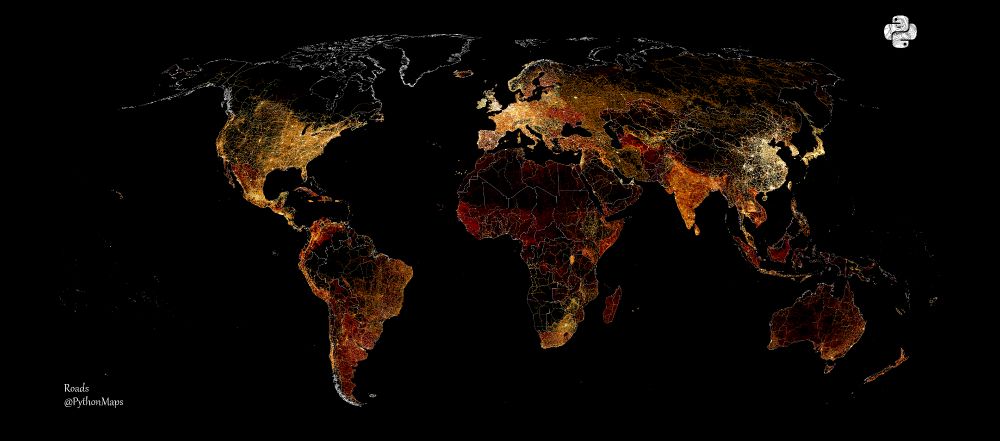
November 8, 2025 at 11:12 PM
Day 8 of the #30DayMapChallenge Urban - Roads of the world. Couldn't think of anything more urban than roads.
Capitalism vs communism eh 😉
Day 7 of the #30DayMapChallenge - Accessibility - "Visualize travel time, barriers....." - Here is a map showing nighttime lights in the Korean Peninsula. The border between North and South is visible from space.

November 8, 2025 at 12:05 AM
Capitalism vs communism eh 😉
Day 7 of the #30DayMapChallenge - Accessibility - "Visualize travel time, barriers....." - Here is a map showing nighttime lights in the Korean Peninsula. The border between North and South is visible from space.

November 7, 2025 at 11:32 PM
Day 7 of the #30DayMapChallenge - Accessibility - "Visualize travel time, barriers....." - Here is a map showing nighttime lights in the Korean Peninsula. The border between North and South is visible from space.
Day 6 of the #30DayMapChallenge - Dimensions. A thread of a few maps that cross into the three dimensional world. Here is a 3D representation of the topography and bathymetry around Gibralta.

November 7, 2025 at 11:32 PM
Day 6 of the #30DayMapChallenge - Dimensions. A thread of a few maps that cross into the three dimensional world. Here is a 3D representation of the topography and bathymetry around Gibralta.
Day five of the #30DayMapChallenge - Earth. Soil moisture. Data comes from the TerraClimate project. I love this colourmap.

November 7, 2025 at 11:31 PM
Day five of the #30DayMapChallenge - Earth. Soil moisture. Data comes from the TerraClimate project. I love this colourmap.
Day four of the #30DayMapChallenge - Data challenge: My Data. I made some historical geojsons of the Roman and Mongol empires. Accuracy is vaguely correct but the Mongol Empire does look a bit like a bear.

November 7, 2025 at 11:11 PM
Day four of the #30DayMapChallenge - Data challenge: My Data. I made some historical geojsons of the Roman and Mongol empires. Accuracy is vaguely correct but the Mongol Empire does look a bit like a bear.
Day 7 of the #30DayMapChallenge - Accessibility - "Visualize travel time, barriers....." - Here is a map showing nighttime lights in the Korean Peninsula. The border between North and South is visible from space.

November 7, 2025 at 11:04 PM
Day 7 of the #30DayMapChallenge - Accessibility - "Visualize travel time, barriers....." - Here is a map showing nighttime lights in the Korean Peninsula. The border between North and South is visible from space.
Day three of the #30DayMapChallenge - Polygons. This map shows the earths tectonic plates. I have overlayed all of the earthquakes with a magnitude greater than 4.0 over the last 20 years, coloured according to their magnitude (blue (smallest) - red (largest).

November 3, 2025 at 9:47 PM
Day three of the #30DayMapChallenge - Polygons. This map shows the earths tectonic plates. I have overlayed all of the earthquakes with a magnitude greater than 4.0 over the last 20 years, coloured according to their magnitude (blue (smallest) - red (largest).
Day 2 of the #30DayMapChallenge - Lines. This map shows the rivers of Africa, coloured according to the minimum river temperature.

November 2, 2025 at 7:14 PM
Day 2 of the #30DayMapChallenge - Lines. This map shows the rivers of Africa, coloured according to the minimum river temperature.
Day one of the #30DayMapChallenge - Points. These maps show lighthouses of the British Isles, the Aegean Sea and Italy. I have tried to simulate how they would shine and cast light out to sea.

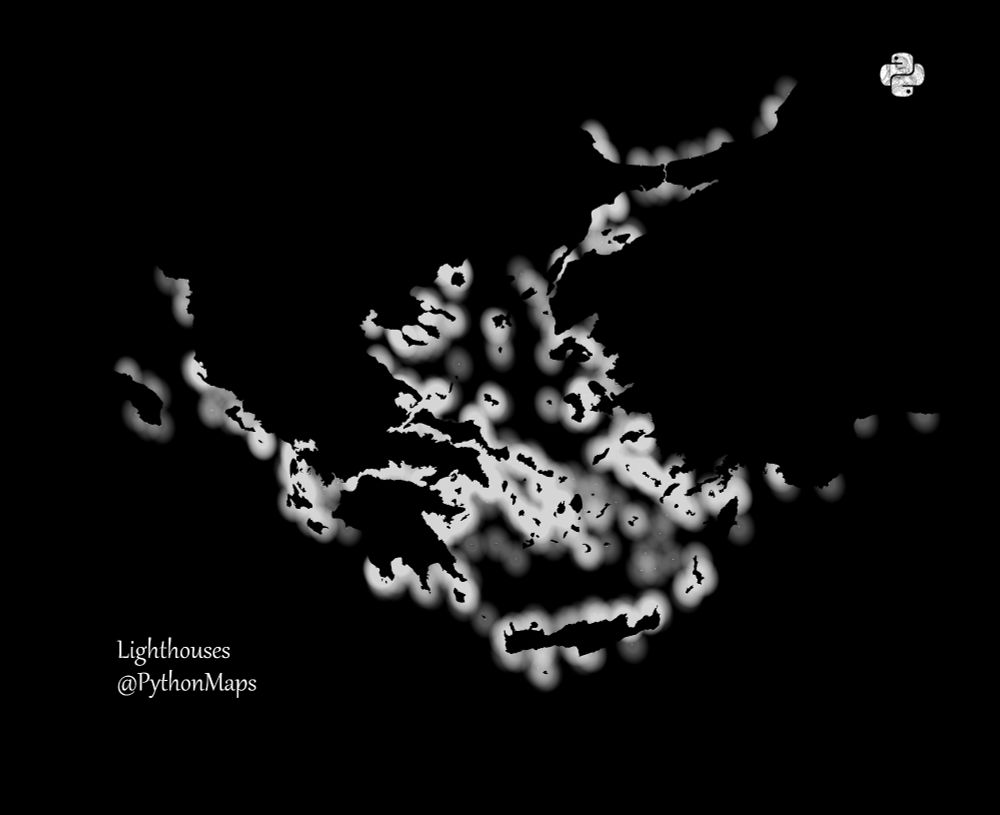

November 1, 2025 at 9:41 AM
Day one of the #30DayMapChallenge - Points. These maps show lighthouses of the British Isles, the Aegean Sea and Italy. I have tried to simulate how they would shine and cast light out to sea.
Croplands. This map shows the croplands of East Asia. Using my new favourite colourmap.
Data - www.nature.com/articles/s43...
Data - www.nature.com/articles/s43...

October 2, 2025 at 8:54 PM
Croplands. This map shows the croplands of East Asia. Using my new favourite colourmap.
Data - www.nature.com/articles/s43...
Data - www.nature.com/articles/s43...
Soil moisture. Data comes from the TerraClimate project.
Is my choice of colourmap appropriate? No.
Do I care? No.
Do I just like making pretty pictures? Yes
Is my choice of colourmap appropriate? No.
Do I care? No.
Do I just like making pretty pictures? Yes

October 1, 2025 at 9:13 PM
Soil moisture. Data comes from the TerraClimate project.
Is my choice of colourmap appropriate? No.
Do I care? No.
Do I just like making pretty pictures? Yes
Is my choice of colourmap appropriate? No.
Do I care? No.
Do I just like making pretty pictures? Yes
Evapaotranspiration. Data comes from the TerraClimate project.

September 27, 2025 at 8:59 AM
Evapaotranspiration. Data comes from the TerraClimate project.
Wildfires. Data aggregated for all of 2024.

August 28, 2025 at 8:35 PM
Wildfires. Data aggregated for all of 2024.
Aridity of Oceania. Aridity is usually expressed as a generalized function of precipitation, temperature and reference evapo-transpiration. Higher values represent more humid conditions and lower values represent higher aridity.

August 24, 2025 at 9:00 PM
Aridity of Oceania. Aridity is usually expressed as a generalized function of precipitation, temperature and reference evapo-transpiration. Higher values represent more humid conditions and lower values represent higher aridity.
Religions of the world coloured by majority religious affiliation. Deeper colours denote greater percentage of people practicing the corresponding religion.

August 20, 2025 at 9:17 PM
Religions of the world coloured by majority religious affiliation. Deeper colours denote greater percentage of people practicing the corresponding religion.
Aridity of North America. Aridity is usually expressed as a generalized function of precipitation, temperature and reference evapo-transpiration. Higher values represent more humid conditions and lower values represent higher aridity. Data from csidotinfo.wordpress.com/2019/01/24/g...

August 19, 2025 at 7:51 PM
Aridity of North America. Aridity is usually expressed as a generalized function of precipitation, temperature and reference evapo-transpiration. Higher values represent more humid conditions and lower values represent higher aridity. Data from csidotinfo.wordpress.com/2019/01/24/g...
Bathymetry of the Gulf of America, the Caribbean and parts of the Atlantic and Pacific.

August 18, 2025 at 6:57 PM
Bathymetry of the Gulf of America, the Caribbean and parts of the Atlantic and Pacific.
This is a bivariate map showing rainfall vs temperature.

August 12, 2025 at 9:34 PM
This is a bivariate map showing rainfall vs temperature.
Few people realise the scale of the Himalayas because static maps are a bad way to convey topography. Fortunately, we can use interactive maps to explore topography. Here is an example using Pyvista.
July 20, 2025 at 12:11 PM
Few people realise the scale of the Himalayas because static maps are a bad way to convey topography. Fortunately, we can use interactive maps to explore topography. Here is an example using Pyvista.
Here is an old favourite. Shipping lanes. This time drawn using the Spilhaus projection, which centers the map on Antartica and presents the worlds oceans as one continuous body. Athelstan F. Spilhaus, a South African-American geophysicist and oceanographer in 1942
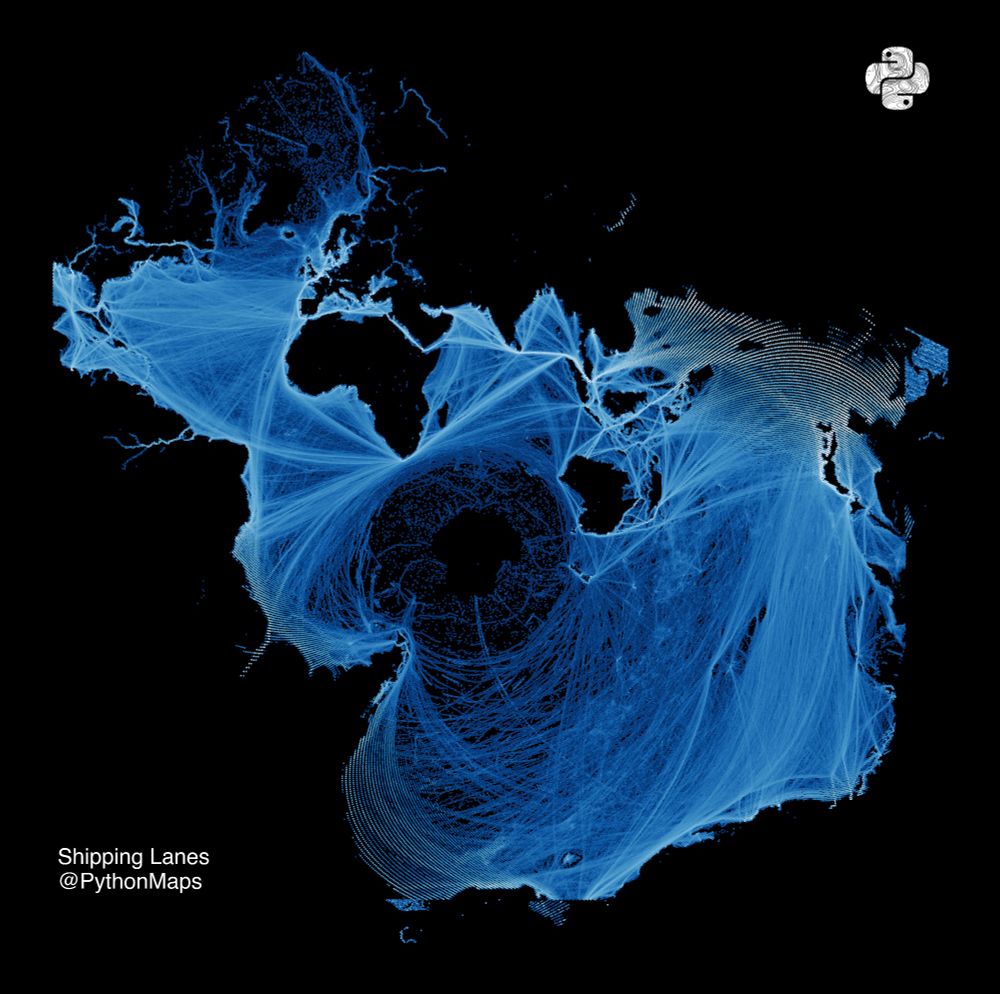
July 14, 2025 at 9:28 PM
Here is an old favourite. Shipping lanes. This time drawn using the Spilhaus projection, which centers the map on Antartica and presents the worlds oceans as one continuous body. Athelstan F. Spilhaus, a South African-American geophysicist and oceanographer in 1942
I have combined two datasets for fun. Here are the world's shipping lanes (red) and the worlds flight paths (white) on the same map.
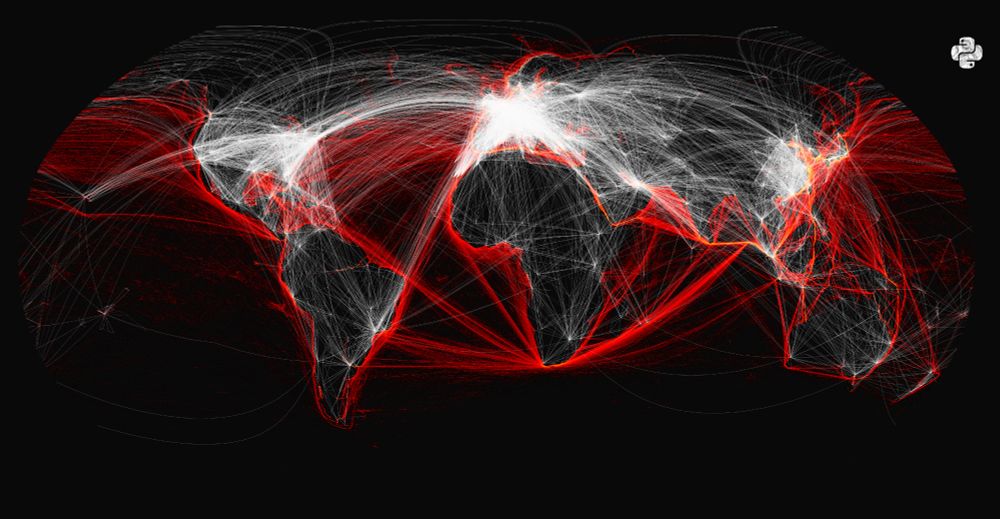
June 18, 2025 at 10:31 PM
I have combined two datasets for fun. Here are the world's shipping lanes (red) and the worlds flight paths (white) on the same map.
Expermineting with different datasets. Plotting a topography map, with contour lines on top creates a really cool hillshading effect. Couple that with rivers and you are getting close to a OS map, all in Python
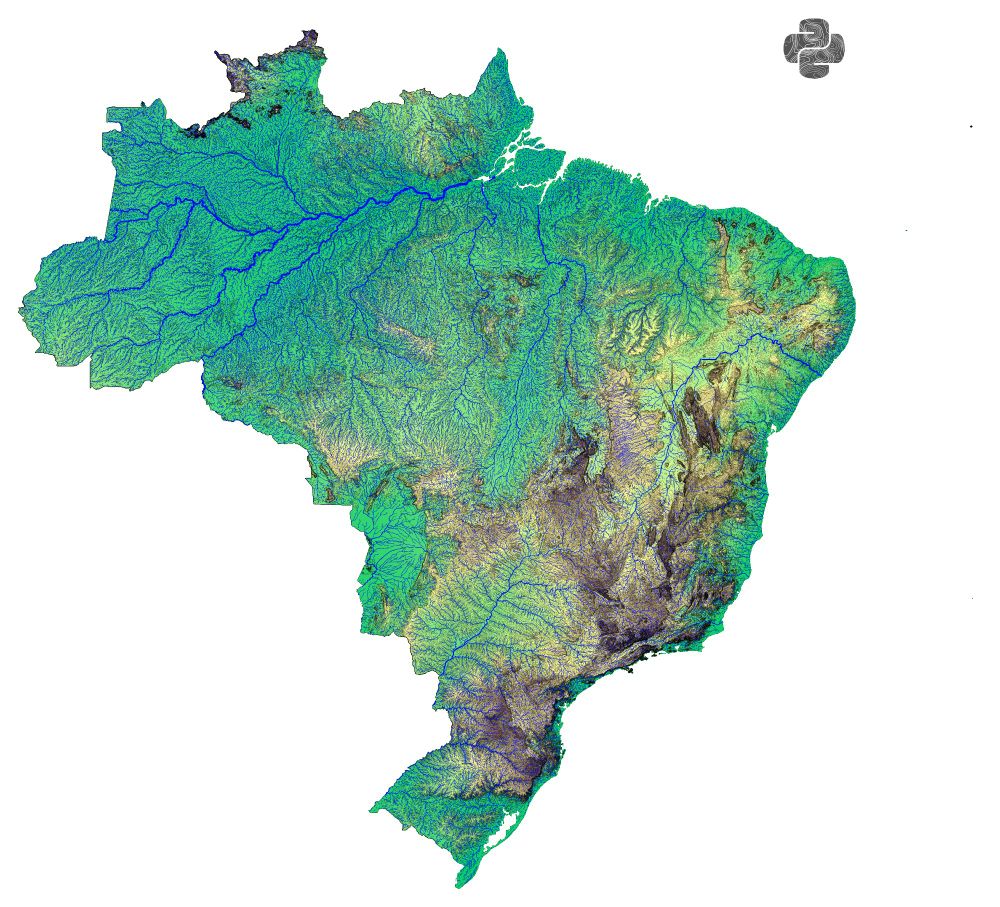
June 7, 2025 at 12:54 PM
Expermineting with different datasets. Plotting a topography map, with contour lines on top creates a really cool hillshading effect. Couple that with rivers and you are getting close to a OS map, all in Python

